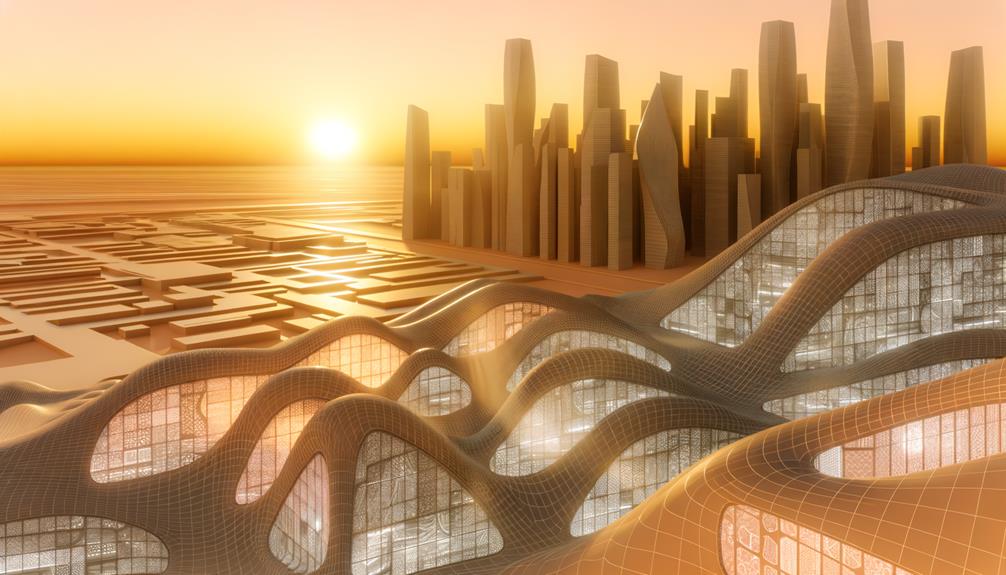Parametric design is revolutionizing the world of modern architecture. By incorporating advanced algorithms and computational tools, architects can now create structures that are both fluid and flexible.
This innovative approach allows for the manipulation of elements such as geometry and spatial relationships. As a result, buildings become more adaptable to both environmental conditions and the needs of their users.
One of the standout benefits of parametric design is its promotion of sustainable practices. By optimizing resource use and enhancing energy efficiency, this method supports a greener future for architecture.
Iconic projects like the Heydar Aliyev Center and the Louvre Abu Dhabi are perfect examples of this blend of creativity and technology. These landmark constructions showcase groundbreaking architectural solutions that push the boundaries of what is possible.
As we continue to explore the potential of parametric design, we witness its ongoing impact on the architectural landscape. This is just the beginning of a new era where creativity meets innovation, redefining how we perceive and interact with our built environment.
Key Takeaways
Parametric design is reshaping the landscape of modern architecture. By utilizing cutting-edge computational tools and algorithms, architects are now able to create structures that are not only visually stunning but also fluid and adaptable.
This innovative approach leverages genetic algorithms and data visualization techniques. These tools optimize spatial relationships, enhance environmental responsiveness, and promote sustainability, making the buildings of tomorrow more efficient and eco-friendly.
Taking inspiration from nature, parametric design incorporates biomimetic structures. This results in dynamic forms that adjust to their surroundings, boosting both adaptability and energy efficiency.
The use of rendering software and advanced computational design tools plays a crucial role in this transformation. They bring architectural concepts to life with photo-realistic images and animations, improving communication with clients and ensuring their visions are accurately realized.
Iconic projects such as the Louvre Abu Dhabi and the Heydar Aliyev Center stand as testaments to the power of parametric design. These structures exemplify the transformative impact this approach has on modern architecture, setting new standards for innovation and creativity.
In essence, parametric design is not just a trend; it’s a revolution. It offers a glimpse into the future of architecture, where creativity meets technology to redefine what’s possible.
Understanding Parametric Design
Unlock the Future of Architecture with Parametric Design
Parametric design is revolutionizing architecture, bringing a new era of fluid and adaptable structures. This cutting-edge approach uses powerful algorithms and computational processes, allowing architects to explore a range of design possibilities effortlessly.
Harnessing the power of parametric modeling, architects can manipulate design elements through sophisticated algorithms. This ability to explore various form generations means responsive environments can be crafted, adjusting seamlessly based on specific criteria.
A key aspect of parametric design is data-driven analysis. This enables the optimization of spatial relationships and architectural layouts, ensuring that every design is as efficient and effective as possible.
At the heart of our process is iteration—refining ideas through continuous testing and modification. This fosters an agile design approach, where user interaction is prioritized. By adjusting parameters, we can meet evolving needs, ensuring flexibility and adaptability in every project.
Adaptability is crucial. Our designs respond to environmental conditions and user requirements, creating spaces that are both functional and aesthetically pleasing.
Through architectural optimization, we strive to deliver the most innovative solutions. By integrating advanced techniques, we’re pushing boundaries and exploring new possibilities in the architectural domain.
As we embrace these technologies, we unlock opportunities for more sustainable, productive, and beautiful designs. Join us on this journey to transform the architectural landscape with parametric design.
Key Principles and Concepts
Discover the transformative world of parametric design!
With an emphasis on the algorithmic design process, parametric architecture empowers us to craft intricate and innovative forms. By setting defined parameters, we can create structures that were once unimaginable with traditional techniques.
The beauty of parametric design lies in its adaptability. Utilizing advanced computational tools, architects can skillfully manipulate these parameters to develop revolutionary architectural solutions that are both versatile and dynamic.
Join us in exploring the future of architecture—where creativity meets technology, and the possibilities are limitless!
Algorithmic Design Process
In the realm of parametric design, the algorithmic design process stands as a groundbreaking method that reshapes our approach to architectural spaces. This innovative process harnesses the power of genetic algorithms to explore numerous design iterations. This means we can refine and perfect architectural forms like never before.
One of the standout features of this process is the integration of data visualization. This allows us to decipher complex data sets, ensuring that our design decisions are informed and precise.
User interaction plays a pivotal role in this process. Stakeholders can engage with design models through user-friendly interfaces, fostering a comprehensive understanding of the design’s possibilities and limitations. This interaction is invaluable, offering insights that might otherwise be overlooked.
Another critical component is environmental responsiveness. Designs are tailored to adapt to specific site conditions, enhancing both performance and sustainability. This ensures that the final architectural product isn’t only functional but also environmentally conscious.
Material investigation is an exciting part of the algorithmic approach. Algorithms simulate the behaviors and properties of different materials, helping us predict their impact on the design. This foresight enriches our architectural storytelling, allowing us to craft narratives that align with the building’s purpose and context.
Dynamic Structural Forms
Exploring the Future of Dynamic Architecture
In the realm of architecture, the future is dynamic, flexible, and adaptive. We’re witnessing a transformation where buildings become lively structural forms, seamlessly blending with their environment. Inspired by nature, these designs draw on biomimetic structures, creating organic shapes that integrate harmoniously with their surroundings.
The potential of kinetic architecture is particularly exciting. Imagine buildings that adapt in real-time, thanks to innovative materials that respond to environmental changes. Interactive facades adjust to light and temperature, optimizing both building performance and the comfort of its occupants.
Modular systems are at the forefront of these advancements, offering unmatched versatility and scalability. By applying principles of fluid dynamics, we enhance airflow and energy efficiency, paving the way for ecological integration and sustainability. Performance optimization is key, ensuring every component of the structure works in synergy.
Energetic structural forms are redefining traditional architecture. We’re not just erecting static buildings; we’re creating living, breathing spaces that harmonize with nature and technology.
This is the future of architectural design—dynamic, innovative, and in tune with the world around us.
Computational Design Tools
Revolutionizing architectural challenges, computational design tools bring a new level of precision and flexibility to the industry. Imagine structures crafted with intricate detail, tailored to your specific needs. These advancements are made possible by integrating design automation with generative algorithms.
Design automation simplifies repetitive tasks, allowing creative minds to focus on innovation. Meanwhile, generative algorithms unlock creative solutions that were once beyond reach. Together, they redefine the possibilities of architectural design.
Performance analysis is crucial. It ensures our designs aren’t just beautiful but also energy-efficient and structurally sound. By refining these elements, we enhance the longevity and sustainability of our projects.
Visualization techniques are vital for clear communication and user interaction. We present designs that are both accessible and informative, ensuring everyone involved can easily understand and engage with the project.
Data-driven design empowers us to make informed decisions. By relying on real-world information and trends, we create spaces that truly resonate with the needs and desires of our clients.
Simulation tools allow for iterative modeling. This means we can test and refine ideas continuously, ensuring the final product is as functional as it’s aesthetically pleasing.
Collaboration is key. Using collaborative platforms, architects, engineers, and clients can work seamlessly together, fostering teamwork and open communication.
Tools and Software in Use
In the realm of parametric design, a suite of advanced tools and software has revolutionized the way architects bring their visions to life. Selecting the right software is crucial at the onset of any project, as it shapes the modeling techniques and design simulations we can employ.
The user interface of these tools plays a pivotal role, impacting how intuitively and efficiently we navigate our projects. Collaborative tools enhance teamwork, boosting creativity and productivity by allowing seamless communication among team members.
Performance analysis features are indispensable, enabling us to assess the structural and environmental dimensions of our designs before construction. Data visualization tools simplify complex datasets, making informed decision-making more straightforward.
With scripting languages and algorithm libraries, we can craft tailor-made solutions, ensuring our designs meet specific project requirements. Rendering software is vital in transforming our concepts into reality, offering photo-realistic images and animations that effectively convey the final design to clients and stakeholders.
By harnessing these tools, we streamline the design process, ensuring our architectural endeavors are both innovative and practical. As we explore these software options, our aim is to continually enhance our capabilities, aligning with our design aspirations.
Impact on Architectural Aesthetics
Parametric design is revolutionizing architectural aesthetics, leading to an exciting evolution in design forms. Gone are the days of traditional, rigid shapes. In their place, we now see groundbreaking and fluid structures that captivate the eye.
This innovative approach allows for the seamless integration of complex geometry, resulting in buildings that aren’t only visually striking but also daringly bold. Embracing these advanced design techniques enhances architectural spaces, offering vibrant visual experiences that both challenge and redefine conventional expectations.
Evolution of Design Forms
The world of architecture has undergone a thrilling transformation, thanks in large part to the evolution of design forms. This journey, steeped in rich history, has been driven by continuous exploration of form and innovation.
Today, our creative processes have warmly embraced geometric transformations, signaling a significant shift in design philosophy. These transformations allow us to explore new horizons in material innovation, prompting an aesthetic evolution that defies traditional norms.
As we delve deeper into this fascinating evolution, several key factors illuminate the path forward:
- Structural Experimentation: By challenging the limits of what’s structurally feasible, architects open new avenues for creative expression and architectural innovation.
- Artistic Influences: The integration of diverse artistic styles enriches architecture’s visual language, adding depth and variety to our built environment.
- Material Innovation: The emergence of new materials paves the way for unique forms that were once beyond imagination.
- Geometric Transformations: Advanced software now enables the creation of complex shapes, redefining our spatial experiences and pushing the boundaries of design.
Together, these elements highlight a transformation that’s reshaping our world.
Today’s architecture reflects centuries of investigation into form, where each new structure builds upon its predecessors, influenced by a rich tapestry of artistic and technical advancements.
We’re privileged to witness this captivating journey of architectural evolution, where aesthetics and function continue to evolve in harmony, crafting spaces that captivate and inspire.
Integration of Complex Geometry
In the world of architecture, we’re witnessing a revolutionary shift with the integration of complex geometry. This transformation is redefining aesthetic boundaries and opening up new possibilities for design.
Architects now have the ability to create visually stunning structures through sophisticated surface modeling. These designs not only challenge traditional forms but also offer adaptive facade systems. The result? Buildings that not only captivate the eye but also interact seamlessly with their environment. They adapt to changing weather and natural light, enhancing both form and function.
Generative patterning is another exciting development. This approach lets architects design intricate patterns inspired by nature and abstract ideas. With responsive design strategies, our buildings now adapt to their surroundings and meet specific needs. The inspiration often comes from biomimetic structures, mimicking nature’s efficiency for sustainable, cutting-edge designs.
Fractal architecture is also making waves. It introduces a sense of spatial fluidity, transforming how we perceive space. By moving beyond rigid forms, architects create fluid spaces that enhance the user experience.
As we explore these concepts further, we’re pushing the boundaries of what’s possible in architecture. The result is a world of new possibilities for aesthetic expression and functional design.
Whether you’re an architect, a client, or simply an admirer of beautiful structures, there’s never been a more exciting time to be part of this evolving landscape.
Dynamic Visual Experiences
Dynamic visual experiences are revolutionizing architectural aesthetics, offering a fresh perspective on how we interact with the spaces around us. Through the lens of parametric design, these experiences are breathing life into architecture, transforming ordinary spaces into vibrant, interactive installations. This shift engages audiences by creating immersive environments that captivate the senses.
Architecture is no longer just about form and function; it has become a medium for visual storytelling. The narratives crafted through design connect with us on a personal level, making each interaction with a space unique and memorable.
One of the key components of these energetic visual experiences is design responsiveness. This concept ensures that structures are dynamic, capable of adapting to our presence and enhancing our sensory engagement. Buildings, once static, now have the ability to respond and react, heightening our sensory experiences.
Several elements contribute to these captivating experiences:
- Interactive Installations: These invite participation, transforming architecture into a collaborative journey.
- Immersive Environments: By leveraging technology and innovative design, these spaces envelop us, shifting our perceptions.
- Sensory Experiences: Engaging multiple senses, these designs create lasting architectural narratives that resonate.
- Visual Storytelling: Through the distinct form and function, designs convey powerful stories and ideas.
Ultimately, these elements forge a deep connection between us and our built environment, enriching our experience. As innovation continues to push boundaries, the potential for creating breathtaking visual experiences remains limitless, promising even more awe-inspiring interactions with architecture in the future.
Innovations in Building Efficiency
In the ever-evolving world of architecture, the drive for greater building efficiency is sparking innovations that are transforming how we design and construct spaces.
Energy Optimization & Sustainability One of the key areas of focus is energy optimization. By utilizing sustainable materials and implementing smart systems, we’re significantly boosting building performance.
Passive design strategies are becoming increasingly popular. These strategies enhance thermal performance, reducing the need for active heating and cooling systems. The result? Lower energy consumption and a reduced environmental footprint.
Resource Management & Space Utilization Effective resource management is crucial. Conducting lifecycle analyses allows us to make informed material and process choices, ensuring long-term sustainability.
Innovation in space utilization is also making waves. Flexible designs maximize building function and efficiency, benefiting owners and engaging users by creating adaptable environments.
Smart Systems Integration Technology integration is revolutionizing building management. From lighting and HVAC to security and maintenance, smart systems are at the forefront.
They deliver real-time data, enabling us to fine-tune operations and boost overall efficiency.
As we continue to embrace these groundbreaking innovations, we’re setting new standards in building efficiency and sustainability. Our commitment to these advancements not only benefits our planet but also enhances the experiences of building owners and users alike.
Case Studies of Iconic Projects
Around the globe, architectural marvels embody the transformative power of parametric design, setting new standards in modern architecture. By weaving together computational innovation and traditional design, these projects mark the dawn of a sustainable architectural era. Delving into these case studies reveals how they harmonize with cultural heritage, minimize environmental footprints, and elevate user experience.
The Louvre Abu Dhabi stands as a beacon of design collaboration and material innovation. Its iconic dome structure echoes historical influences while prioritizing eco-friendly principles. Visitors and critics alike have praised its seamless blend of the past and present, making it a must-visit for architecture enthusiasts.
In Azerbaijan, the Heydar Aliyev Center captivates with its fluid, modular form. This structure is a testament to architectural storytelling, resonating deeply with the local cultural narrative. Many visitors have expressed awe at its ability to reflect Azerbaijan’s rich heritage while offering a futuristic experience.
Beijing’s National Stadium, affectionately known as the Bird’s Nest, is a masterclass in integrating computational creativity with sustainable design. It’s hailed for its unique aesthetic and the exceptional user experience it provides, drawing visitors from around the world.
Lastly, the Al Bahar Towers impress with their innovative responsive façade. This architectural wonder adapts to environmental conditions, merging historical influences with cutting-edge technology. Visitors have lauded its pioneering approach and the visual spectacle it offers.
These projects collectively showcase the revolutionary impact of parametric design. They not only push the boundaries of architectural possibilities but also inspire future endeavors to thoughtfully integrate advanced technologies with timeless design principles.
Challenges and Limitations
While parametric design has revolutionized modern architecture, it comes with its own unique set of challenges and limitations. As projects grow in complexity, scalability issues can arise, making it difficult to maintain consistency across large scales. This can lead to design rigidity, potentially hampering user adaptability. Changes may not be easily accommodated, which is a significant consideration in dynamic architectural environments.
Moreover, navigating the skill barriers of parametric design can be daunting. It often demands specialized knowledge, which may limit accessibility for some architects. This presents an opportunity for professional growth and training, encouraging architects to expand their skill set.
Computational constraints can also present hurdles. Complex algorithms often require substantial computing power, which could slow down the design process. However, with advancements in technology, these challenges can be mitigated over time.
Collaboration is key in any project, yet integrating diverse team members‘ inputs can be tricky. Differences in software and expertise can pose challenges, but they also open avenues for learning and innovation. By fostering open communication and collaboration, teams can overcome these obstacles together.
Maintaining parametric models is essential for their functionality over time. Regular updates are necessary, and this ongoing maintenance can be seen as an investment in the longevity and success of the design.
Client understanding is crucial, and explaining the benefits and limitations of parametric designs to those unfamiliar with the technology is a task that requires patience and clear communication. This is an opportunity to educate and inspire clients about the potential of parametric design.
Data management is another critical factor. Ensuring accuracy and efficiency is vital, and requires careful handling. Additionally, regulatory compliance can sometimes be an obstacle, as cutting-edge designs may not always align with existing building codes and standards. Addressing these challenges requires a balanced approach and transparent communication among all stakeholders.
Future Trends in Parametric Design
Let’s explore the exciting future of parametric design, a field that continues to break boundaries and redefine the landscape of architecture. As we look forward, several dynamic trends are emerging, promising to enhance how we design and build spaces.
1. Sustainable Practices Parametric design is set to play a pivotal role in advancing sustainable architecture. By optimizing resource use, minimizing waste, and enhancing energy efficiency, this approach supports the creation of environmentally friendly buildings.
It’s a win for both design and the planet.
2. Cultural Influences Incorporating cultural elements into design is becoming more prevalent. Parametric design allows for the seamless integration of local and global cultural motifs, ensuring that designs resonate with diverse communities.
This approach not only respects cultural heritage but also enriches the overall design narrative.
3. Material Advancements Innovations in materials are driving the future of construction. Parametric design is at the forefront, exploring new materials that offer superior performance and sustainability.
This exploration leads to groundbreaking developments in how structures are built and experienced.
4. User Interaction Enhancing user experience is a key focus. Parametric design facilitates customizable and adaptive solutions, allowing spaces to be tailored to individual preferences and needs.
This trend is set to revolutionize how we interact with our environments.
Beyond these trends, collaboration between architects and engineers is becoming more seamless, fostering innovative solutions. Education will play a crucial role in equipping future designers with the skills to leverage parametric tools effectively.
Regulatory considerations remain vital. As design practices evolve, ensuring compliance with building codes and standards is essential.
Moreover, global perspectives will influence how parametric design adapts to varied environmental, social, and economic contexts.
Together, these elements are set to redefine architecture. The future promises spaces that aren’t only functional but also meaningful and sustainable, enhancing the way we live and interact with our built environment.
Final Thoughts
Parametric design is revolutionizing the field of architecture, much like the transformative impact of the Renaissance on art. By utilizing advanced tools, architects are now able to push the boundaries of creativity and enhance efficiency in the construction of our built environments.
Iconic projects around the world showcase the immense potential of parametric design. These projects not only highlight innovative aesthetics but also demonstrate improved functionality. However, as we continue to refine these techniques, challenges remain.
The future of architecture depends on our ability to adapt and innovate. Parametric design is poised to become more than just a tool; it is emerging as a new language in modern architecture. Embracing this approach will be crucial in shaping the skyline of tomorrow.











